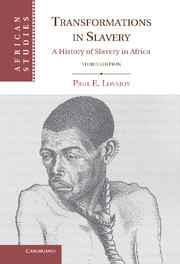Book contents
- Frontmatter
- Contents
- Maps and Tables
- Note on Currencies, Weights, and Measures
- Preface
- Preface to the Second Edition
- Preface to the Third Edition
- 1 Africa and Slavery
- 2 On the Frontiers of Islam, 1400–1600
- 3 The Export Trade in Slaves, 1600–1800
- 4 The Enslavement of Africans, 1600–1800
- 5 The Organization of Slave Marketing, 1600–1800
- 6 Relationships of Dependency, 1600–1800
- 7 The Nineteenth-Century Slave Trade
- 8 Slavery and “Legitimate Trade” on the West African Coast
- 9 Slavery in the Savanna during the Era of the Jihads
- 10 Slavery in Central, Southern, and Eastern Africa in the Nineteenth Century
- 11 The Abolitionist Impulse
- 12 Slavery in the Political Economy of Africa
- Epilogue
- Appendix Chronology of Measures against Slavery
- Notes
- Select Bibliography
- Index
- Books in this series
Preface
Published online by Cambridge University Press: 05 June 2012
- Frontmatter
- Contents
- Maps and Tables
- Note on Currencies, Weights, and Measures
- Preface
- Preface to the Second Edition
- Preface to the Third Edition
- 1 Africa and Slavery
- 2 On the Frontiers of Islam, 1400–1600
- 3 The Export Trade in Slaves, 1600–1800
- 4 The Enslavement of Africans, 1600–1800
- 5 The Organization of Slave Marketing, 1600–1800
- 6 Relationships of Dependency, 1600–1800
- 7 The Nineteenth-Century Slave Trade
- 8 Slavery and “Legitimate Trade” on the West African Coast
- 9 Slavery in the Savanna during the Era of the Jihads
- 10 Slavery in Central, Southern, and Eastern Africa in the Nineteenth Century
- 11 The Abolitionist Impulse
- 12 Slavery in the Political Economy of Africa
- Epilogue
- Appendix Chronology of Measures against Slavery
- Notes
- Select Bibliography
- Index
- Books in this series
Summary
Preface
This is a work of synthesis. As such, it suffers from the same deficiencies that all studies of its sort do. I have examined some parts of the continent in much greater detail than others in preparing this book, and I have relied on secondary sources extensively, although there has been some use of primary material. Very likely there are points with which specialists will disagree, because the scope of the topic makes it impossible to be fully aware of the debates that affect particular periods and areas. Nonetheless, the study of African history, and more specifically the analysis of slavery in Africa, has suffered from the opposite problem to that of oversynthesis. There is virtually no historical framework in which the reconstruction of the history of slavery can be set. The numerous local studies that exist are uneven in quality and frequently are presented in a quasi-historical setting that is fraught with enormous methodological difficulties. Often studies of adjacent areas make no reference to each other. Sometimes, analysis is divorced from all outside influence, as if slavery in Africa existed in a vacuum. There are some brilliant local studies that have their own implications in terms of the study of slavery in general, but these, too, suffer from a failure to place the particular case in the context of Africa as a whole, or even specific regions within Africa.
With these problems in mind, I set out to write an interpretative essay, titled “Indigenous African Slavery,” which was presented at a conference on new directions in slave studies at the University of Waterloo in April 1979. I uncovered so much material that a more extensive project was necessary to consider the issues identified. That essay is in part a bibliographical study that can be used to accompany this book. It is incomplete, even with respect to relatively available materials, and it does not examine the extensive archival information that can be used for a study of this sort, although some archival material has been surveyed. In short, the collection and examination of source material continues, but the present volume is a necessary step in the further study of slavery.
- Type
- Chapter
- Information
- Transformations in SlaveryA History of Slavery in Africa, pp. xiii - xviPublisher: Cambridge University PressPrint publication year: 2011
- 1
- Cited by

